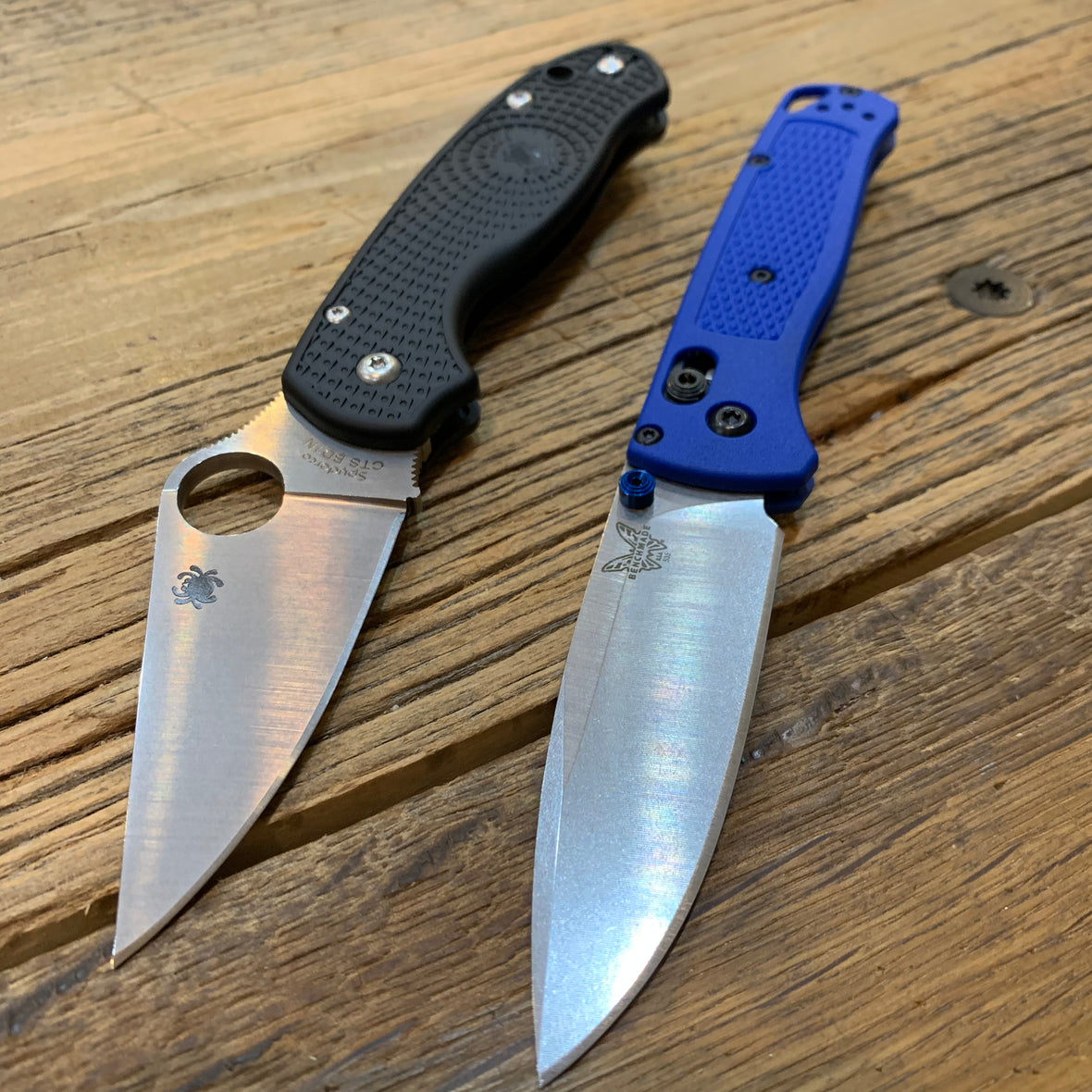
Battle of the Lightweights: Spyderco Para 3 Lightweight vs Benchmade Bugout
147 comments
At SHOT Show 2017 when Spyderco debuted the Spyderco Para 3, they almost immediately knew it would be a massive hit. When the original Spyderco Military debuted in 1997, it quickly rose to become a very popular and recognized model for collectors and users alike. The only downside to the Military was that many viewed it as too large of a knife. Because of this, Sal and his team sat back down and went to the drawing board to try and come up with a smaller version of the Military. In 2004, Spyderco fulfilled the wishes of many and debuted the Spyderco Paramilitary and it was an instant hit. In 2010, the current generation of the Paramilitary 2 (PM2) debuted and brought some upgraded features such as a larger lanyard hole and the ability to move the pocket clip to four different positions. While the PM2 is one of the bestselling knives of the modern era, many people started to see it as being too large of a knife for Everyday Carry (EDC). Finally in 2017, the Para 3 was finally born – a scaled down version of a scaled down version. Its three-inch CPM-S30V was a great size for EDC, the blade offered great performance, and it allowed for a good price. In 2019, Spyderco began a push to make more lightweight models of their already very popular and well known knives such as the Spyderco Police, Sage 5, and the Para 3. With all of this being said, Spyderco isn’t the lone dog in this and faces some stiff competition from Benchmade.
Benchmade released the 535 Bugout in the latter half of 2017. They marketed it as “the modern outdoor adventurer, incorporating the lightest, best performing materials in an extremely slim yet ergonomic package.” The Bugout is 100% this. It is extremely light, comfortable in both the hand and pocket, and is great for EDC as well as a minimalist outdoor knife. The Bugout wasn’t the first ultralight knife for Benchmade. Years before the Bugout came out, Benchmade had the 530 Pardue. The 530 was light, thin, and priced well, but it lacked in ergonomics and its blade shape was one that wasn’t necessarily built to do much more than open packages. The Bugout built upon the 530 and provided a much more ergonomic grip as well as usable blade shape while still maintaining a thin a light profile. To many, the Bugout is as good as they come for lightweight everyday knives, but the new Spyderco Para 3 Lightweight and some of Spyderco’s other models are vying for position of being the best one on the market.
So now that you know a little about the history of how Spyderco designed the Para 3 and where it can trace its roots back to as well as some about Benchmade and the background of the Bugout, here are some important factors to consider between the two.
- Weight – Per the name, the Para 3 Lightweight (LW) is well – lightweight. It only weighs in at a very comfortable 2.4 Ounces (68 grams) which makes it just heavy enough to know that is still in your pocket, but not so heavy that you feel weighed down by it. The Bugout weighs in at an unbelievably light 1.84 Ounces (52 grams) making it a fair amount lighter than the Para 3 LW. Some people have said they feel the Bugout is almost too light in the hand and or pocket and that it doesn’t feel substantial enough to tackle more difficult tasks.
- Size – The Para 3 LW fits the bill for many people as a perfect sized knife. Its blade is just a smidge under three inches and its handle is just a little over four and one quarter inches making it comfortable for people with smaller or somewhat larger hands. It is also only 0.46 inches thick and has a deep carry pocket clip allowing for a knife that rides low in the pocket and doesn’t feel too bulky. The Bugout also fits the bill for many people as far as a perfect sized knife goes. It’s blade is slightly longer coming in at just shy of three and one quarter inches but its handle is slightly shorter coming in at just under four and one quarter inches. The Bugout barely edges out the Para 3 Lightweight in terms of thickness coming in at only 0.42 inches thick and it also comes with a deep carry clip that allows it to sit nice and low in the pocket.
- Blade Steel – While the typical Para 3 and the rest of the Paramilitary come in Crucible’s CPM-S30V steel, the Para 3 LW comes in Carpenter’s CTS® BD1N steel, a nitrogen-enriched high-carbon chromium steel that offers a superior balance of hardness, edge retention, and corrosion resistance. Various edge testing performed by different people throughout the knife community has verified these claims and begs the question whether or not Spyderco might begin to use this more frequently for new models or possibly even as a new steel in a new generation of a knife such as the Manix 2 Lightweight. The Bugout comes in the ever popular CPM-S30V steel, a martensitic stainless steel designed to offer the best combination of toughness, wear resistance and corrosion resistance. Both the Bugout and Para 3 LW have a similarly heat treated blade and will likely perform extremely similarly so this one is really a tossup.
- Price – Price is generally a very important factor for many knife enthusiasts and really anybody so Spyderco wanted to price the Para 3 LW as economically as possible at only $91 to make it more attainable for people that might not to buy as expensive of a knife or are on a tighter budget. Personally, I believe the Para 3 LW is an absolute bargain for what you are getting. It is lightweight, thin, comfortable, and offers a great blade steel. What more could you really ask for. When you look at other similar lightweight offerings from Spyderco such as the Delica 4 or Native 5 in FRN, the Delica is only $13 cheaper and you lose a lot in comparison such as a better blade steel, the compression lock, and more ergonomic and comfortable handle. The same can more or less be said for the Native 5 LW considering it is $6.50 more and the only real advantage, a marginal one based on various tests done, is the S30V steel blade compared to the CTS® BD1N. All considering, Benchmade managed to price the Bugout at a very reasonable price. The standard Blue version of the Bugout can be had for $119, close to $30 more than that of the Spyderco Para 3 LW. Some people might find the Bugout to still be a better deal since it is slightly lighter and thinner and Benchmade’ s LifeSharp warranty would allow for things like screws and pocket clips to be shipped out free of charge.
So if you take all of these factors into consideration, the best knife is? Really the best knife between these two is going to be your decision. At the time of this being written, the Bugout has excellent aftermarket support for various scales from companies such as Flytanium, RockScale Design, and Rogue Bladeworks making it a very attractive option for people wanting to truly make their knives their own. I speculate that we will slowly begin to see these companies and more follow suit and begin to make different handle scales for the Para 3 Lightweight if they haven’t began to do so already. One other advantage that the Bugout has over the Para 3 Lightweight at the time this is being written is that the Bugout can be had in both a Blue handle and Ranger Green handle direct from Benchmade. I once more speculate that Spyderco will offer some different options from the factory and many companies will offer exclusive to them versions, but at this time, the Para 3 Lightweight is only available with a black handle and satin blade. Overall, both the Bugout and Para 3 LW are excellent options and I couldn’t fault you for getting either one or both of them. Thanks for reading and check back next Monday for a new post!
Spyderco Para 3 Lightweight <--- Get One Here!
Benchmade 535 Bugout <--- Get One Here!



Comments (147)
JayPgkUWORmFv
wmigdxLO
hyVSvMpsIuAn
bBxuOFMvoED
DPovmwWtEyiF
rozdbpFUWYwN
DwlUcujkrxG
FXRNQPUYmwK
VDyPiCktKwTj
wgayWYTSdH